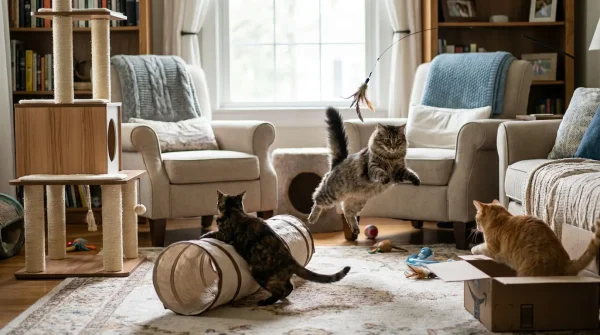Guide to Indoor Cat Exercise Ideas
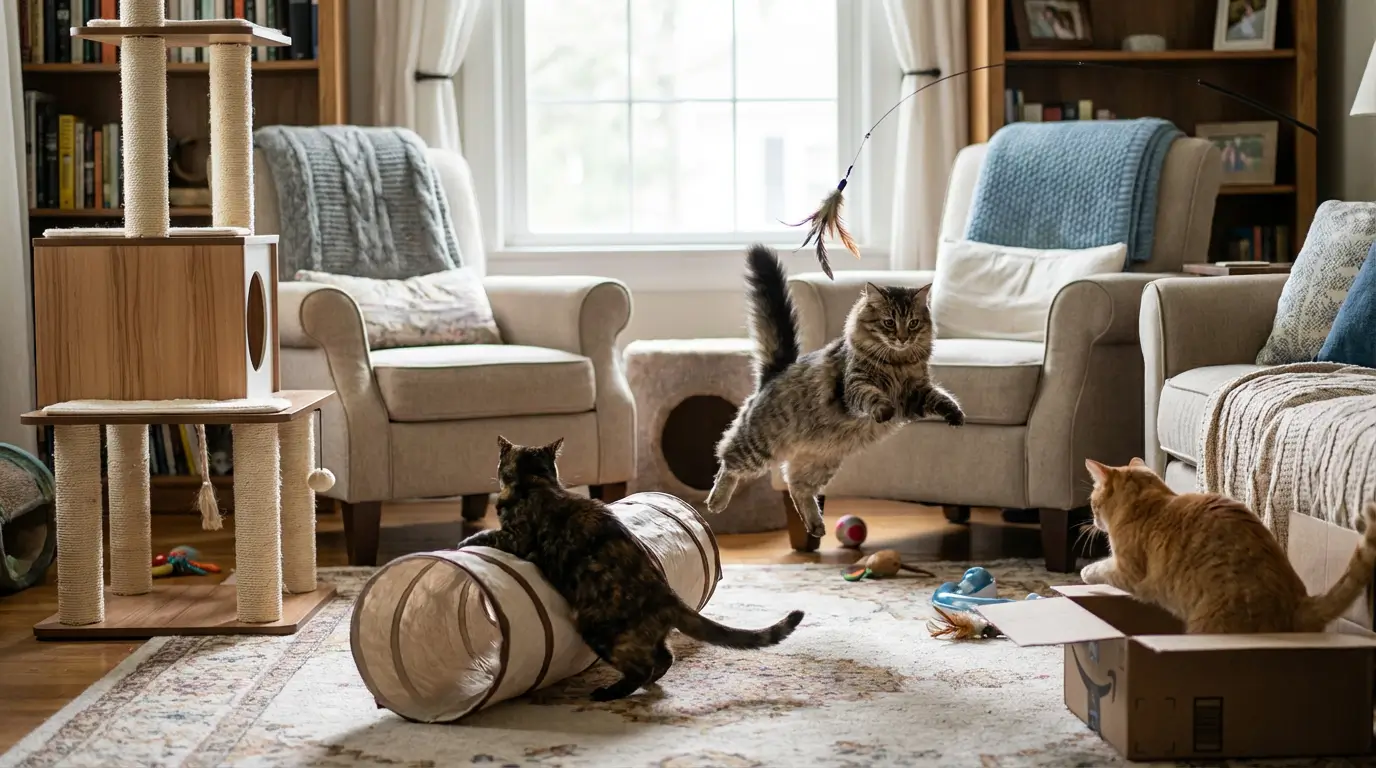
Guide to Indoor Cat Exercise Ideas
Indoor cats often miss out on the natural hunting, climbing, and exploring that outdoor cats enjoy. Over time, this lack of movement can lead to boredom, weight gain, and health issues such as obesity or diabetes. This practical guide shares easy-to-use indoor cat exercise tips to keep your feline friend active, confident, and content at home.
You will discover your cat’s daily exercise needs, simple games you can play in any flat, enrichment toys that encourage natural hunting instincts, and essential safety checks. Whether you care for an energetic youngster or want to refresh an older cat’s routine, these inspiring cat enrichment ideas will help you build a safe, stimulating indoor world your cat will genuinely love.
ℹ️ Did You Know? Many indoor cats sleep 12–16 hours a day. Planned play sessions help balance that downtime with healthy movement and vital mental stimulation.
Understanding the Importance of Exercise for Indoor Cats
Indoor living protects cats from traffic, predators, and harsh weather, but it also limits their opportunities to move and explore. Without regular activity, cats can become lethargic and more prone to health problems. Exercise helps maintain a healthy weight, strengthens muscles and joints, and supports mental well-being by mimicking natural behaviours such as stalking, chasing, climbing, and pouncing.
“Regular play reduces stress and helps prevent destructive behaviours such as scratching furniture or over-grooming. For indoor cats, structured exercise is essential to replicate the energy expenditure of outdoor exploration.” – Veterinary experts
Incorporating fun indoor cat activities into your daily routine can significantly improve your cat’s quality of life. Start by observing your cat’s natural energy levels and play style. Some breeds, such as Bengals, Abyssinians, or Siamese, often need more activity than more laid-back Persians or British Shorthairs.
Tailor exercise sessions to your cat’s age, health, and personality so they stay safe, positive, and enjoyable. Short, focused bursts of movement usually work better than one long session.
💡 Key Insight
Think of play as your cat’s daily “job”. Regular exercise provides purpose, challenge, and satisfaction, helping to reduce anxiety and destructive behaviours around the home.
How Much Exercise Does an Indoor Cat Need?
Most indoor cats benefit from at least two to three structured play sessions each day, lasting around 5–10 minutes each. High-energy cats may enjoy even more frequent, shorter bursts of activity, while senior cats usually prefer slower, low-impact games.
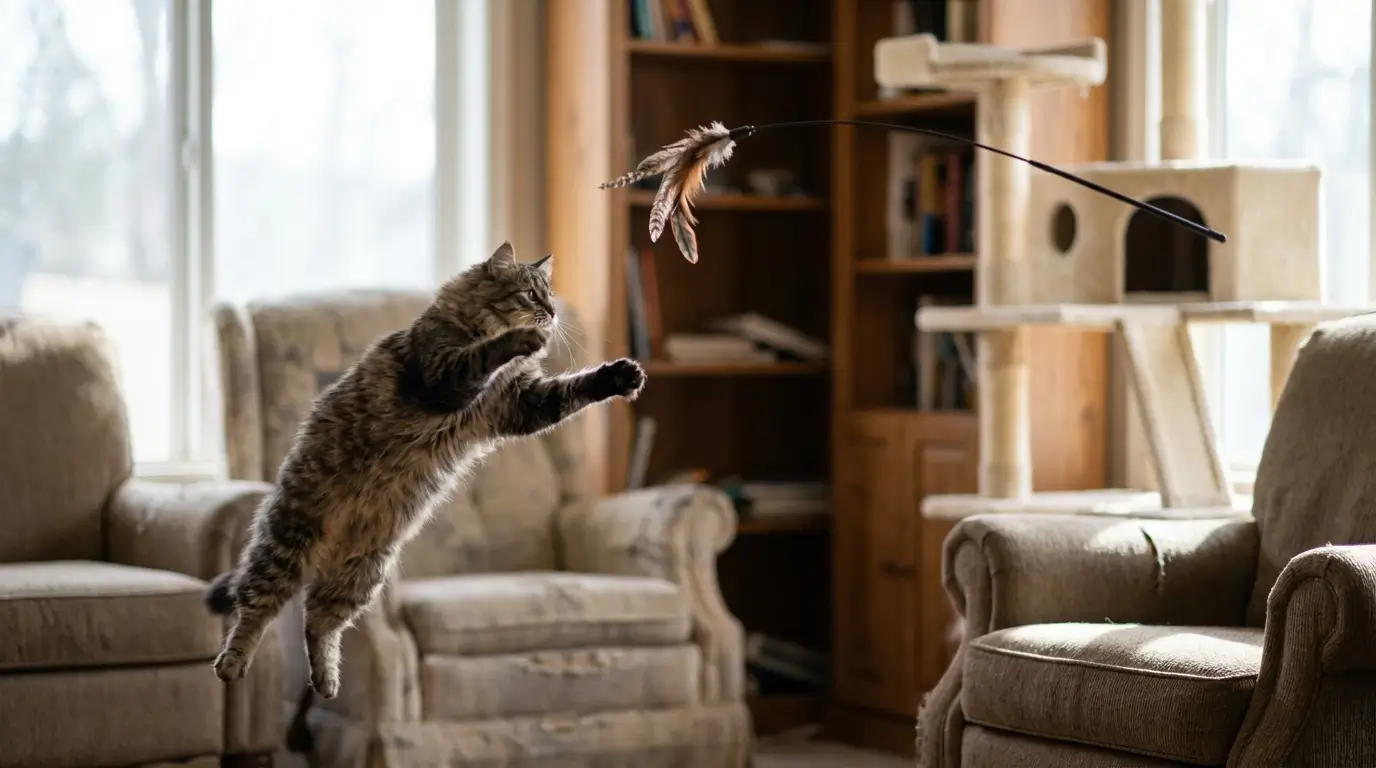
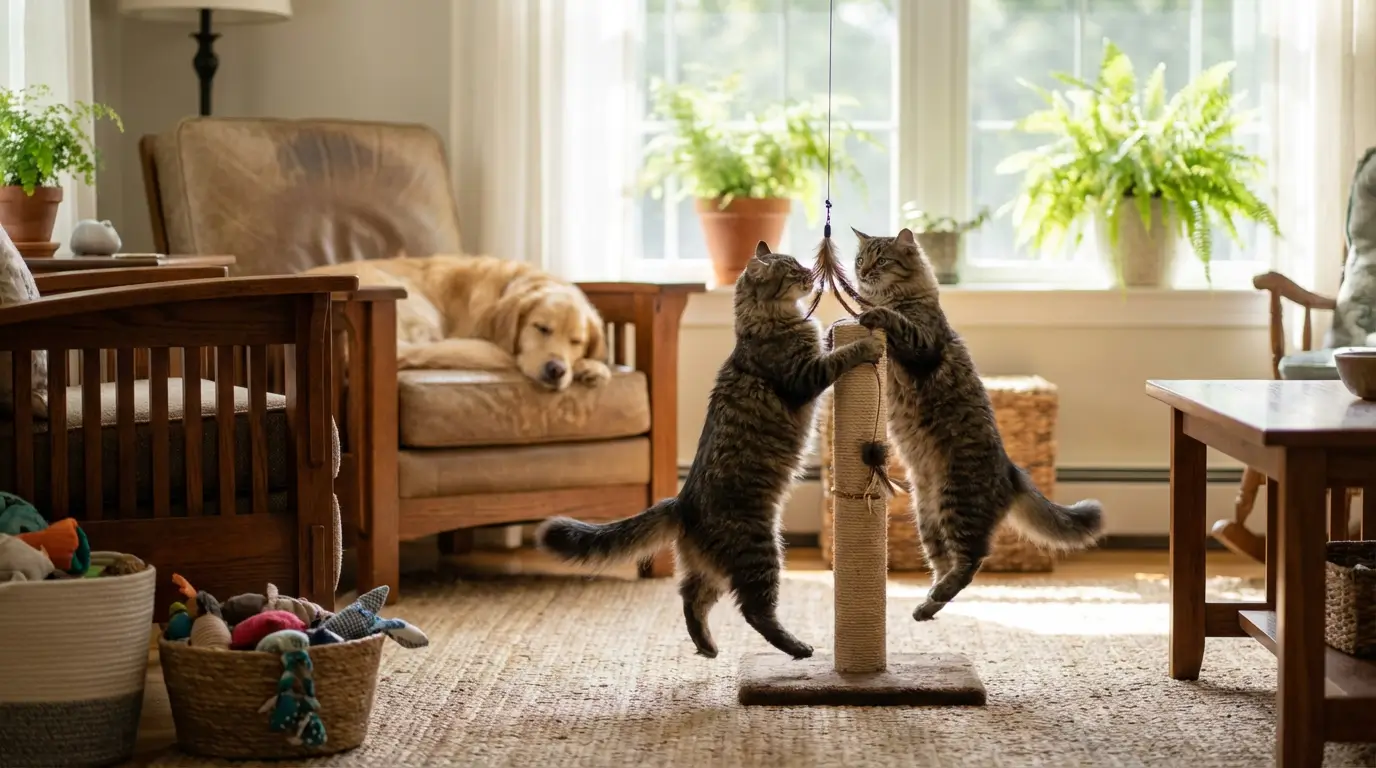

| Life stage | Ideal exercise style |
|---|---|
| Kittens and young cats | Several short, energetic sessions that allow chasing, pouncing, and climbing. |
| Adult cats | Two to three daily play blocks that mimic hunting and exploring. |
| Senior cats | Gentle, low-impact movement such as slow wand games and easy climbing. |
Simple Indoor Games Your Cat Will Love
You do not need a large home to create an exciting exercise routine. A few clever games can turn any room into a safe playground for your cat.
Interactive hunting games
Use wand toys, feather teasers, or toys on a string to mimic the movement of real prey. Move the toy away from your cat in short, quick bursts, letting them stalk, chase, and pounce. Always allow a “catch” at the end so your cat feels successful.
Chase, hide, and pounce
Encourage your cat to dart through tunnels, around furniture, or behind boxes. Crinkly tunnels, paper bags without handles, and cardboard forts all provide fun ambush spots that stimulate natural hunting instincts.
- ✓ Schedule play just before mealtimes to mirror a natural hunt–eat–groom–sleep pattern.
- ✓ End each session with a calm stroke or treat to help your cat wind down.
- ✓ Rotate toys every few days so they stay novel and exciting.
🎯 Quick Start Play Plan
Aim for one morning and one evening play session. Spend the first half gently warming up, then build to faster chases before slowing things down again.
Enrichment Toys and DIY Ideas
Toys that dispense food or move unpredictably keep your cat’s brain just as active as their body. Mixing shop-bought toys with simple homemade options offers variety without a large budget.
Shop-bought toys
Puzzle feeders, treat balls, motion-activated toys, and climbing trees provide structured ways for your cat to work, think, and move for rewards.
DIY enrichment
Use cardboard boxes, loo roll tubes, and blankets to build hiding spots, tunnels, and foraging games that keep your cat curious and engaged.
Creating an Active Indoor Environment
A thoughtfully arranged home encourages your cat to climb, jump, and explore throughout the day, even when you are busy.
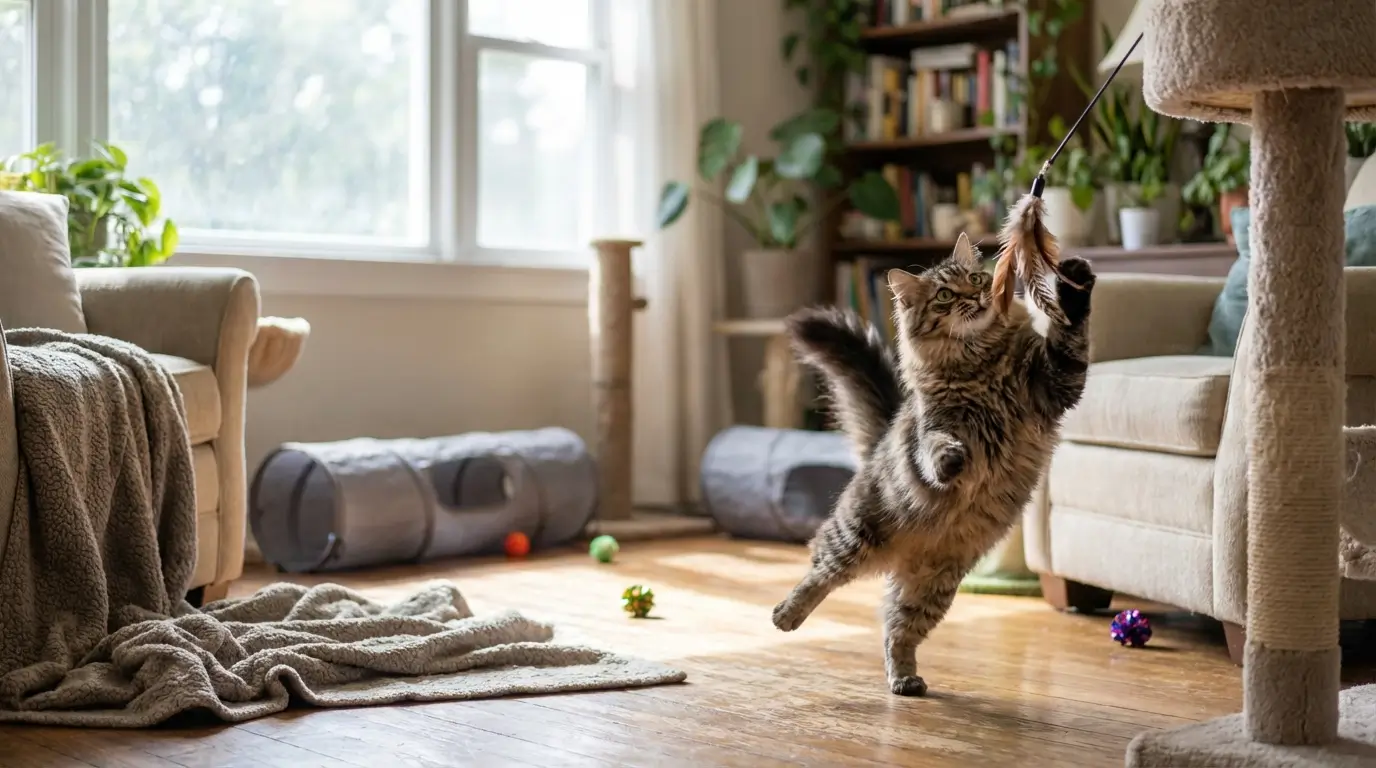
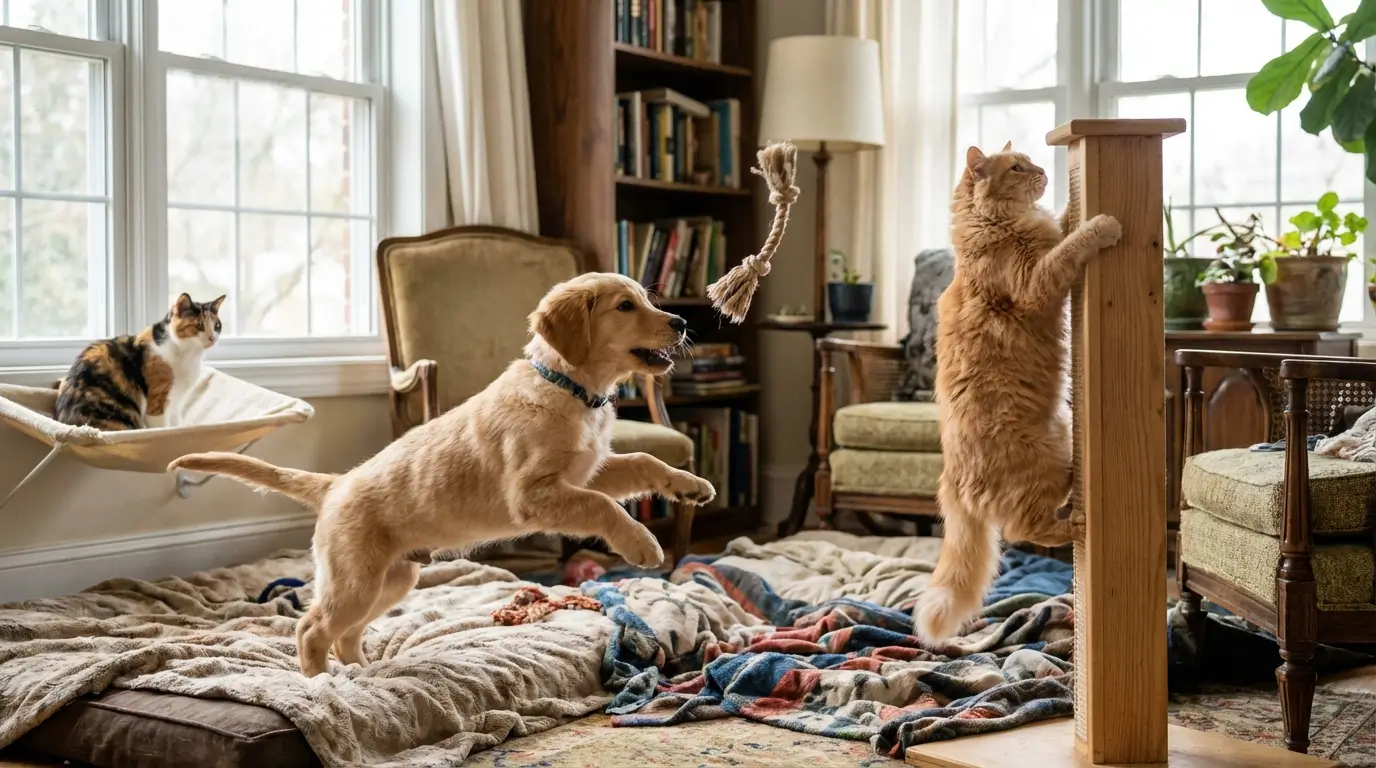

Provide a mix of vertical spaces, scratching options, and safe observation points near windows. Placing beds and perches at different heights naturally invites climbing and gentle jumping.
| Vertical enrichment | Horizontal enrichment |
|---|---|
| Cat trees, sturdy shelves, window hammocks, and tall scratching posts. | Play tunnels, floor-level beds, puzzle feeders, and scattered toys to chase. |
⚠️ Important Note: Always check that shelves, trees, and furniture used for climbing are stable and secure. Remove loose objects your cat could knock over or swallow during energetic play.
Safety Tips for Indoor Cat Exercise
While exercise is essential, it should always feel safe and positive. Avoid forcing your cat to continue once they seem tired, stressed, or disinterested, and keep a close eye on older cats or those with existing health conditions.
Use toys that allow a safe distance between your hands and your cat’s claws, and supervise play with strings, ribbons, or small objects that could be swallowed. If you notice limping, breathing changes, or a sudden reluctance to move, arrange a check-up with your vet before resuming energetic games.
Bringing It All Together
A well-exercised indoor cat is more relaxed, confident, and content. By combining structured play sessions, smart enrichment toys, and an engaging environment, you can mimic the best parts of outdoor life while keeping your cat safe indoors.
Start small with one or two new indoor cat exercise ideas, then gradually build a varied routine that suits your cat’s unique energy levels and personality. With a little planning and creativity, your home can become a rich, rewarding world your cat will enjoy exploring every single day.


